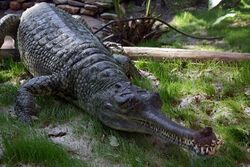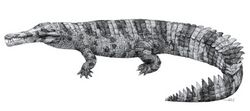Biology:Gavialinae
| Gavialinae | |
|---|---|

| |
| Indian gharial, Gavialis gangeticus | |

| |
| Hanyusuchus | |
| Scientific classification | |
| Domain: | Eukaryota |
| Kingdom: | Animalia |
| Phylum: | Chordata |
| Class: | Reptilia |
| Clade: | Archosauromorpha |
| Clade: | Archosauriformes |
| Order: | Crocodilia |
| Family: | Gavialidae |
| Subfamily: | Gavialinae Nopcsa, 1923 |
| Genera | |
| |
Gavialinae is a subfamily of large semiaquatic crocodilian reptiles, resembling crocodiles, but with much thinner snouts. Gavialinae is one of the two major subfamilies within the family Gavialidae - the other being the subfamily Tomistominae, which contains the false gharial and extinct relatives.
Classification
Gavialinae was first proposed by Nopcsa in 1923, and was cladistically defined by Brochu in 2003 as Gavialis gangeticus (the gharial) and all crocodylians more closely related to it than to Tomistoma schlegelii (the false gharial).[2] This is a stem-based definition for gavialinae, and means that it includes more basal extinct gavialine ancestors that are more closely related to the gharial than to the false gharial.
The false gharial was once thought to be only distantly related to the gharial despite its similar appearance. The false gharial and other tomistomines were traditionally classified within the superfamily Crocodyloidea as close relatives of crocodiles, based solely on morphological evidence.[3] However, recent molecular studies using DNA sequencing have found that they are in fact more closely related to each other than any other extant (living) crocodilian.[3][4][5][6][7]
The placement of extinct gavialids between Gavialinae and Tomistominae is unresolved.
The below cladogram is from the 2022 Iijima et al. study:[8]
| |||||||||||||||||||||||||||||||||||||||||||||||||||||||||||||||||||||||||||||||||||||||||||||||||||||||||||||||||||||||||||||||||||||||||||||||||||||||||||||||||||||||||||||||||||||||||||||||||||||||||||||||||||||||||||||||
References
- ↑ Brochu, Christopher A. (2004). "A new Late Cretaceous gavialoid crocodylian from eastern North America and the phylogenetic relationships of thoracosaurs". Journal of Vertebrate Paleontology (Christopher A. Brochu) 24 (3): 610. doi:10.1671/0272-4634(2004)024[0610:ANLCGC2.0.CO;2]. ISSN 0272-4634. https://www.tandfonline.com/doi/abs/10.1671/0272-4634%282004%29024%5B0610%3AANLCGC%5D2.0.CO%3B2. Retrieved May 3, 2003.
- ↑ Rio, Jonathan P.; Mannion, Philip D. (6 September 2021). "Phylogenetic analysis of a new morphological dataset elucidates the evolutionary history of Crocodylia and resolves the long-standing gharial problem". PeerJ 9: e12094. doi:10.7717/peerj.12094. PMID 34567843.
- ↑ 3.0 3.1 Gatesy, Jorge; Amato, G.; Norell, M.; DeSalle, R.; Hayashi, C. (2003). "Combined support for wholesale taxic atavism in gavialine crocodylians". Systematic Biology 52 (3): 403–422. doi:10.1080/10635150309329. PMID 12775528. http://www.faculty.ucr.edu/~mmaduro/seminarpdf/GatesyetalSystBiol2003.pdf.
- ↑ Harshman, J.; Huddleston, C. J.; Bollback, J. P.; Parsons, T. J.; Braun, M. J. (2003). "True and false gharials: A nuclear gene phylogeny of crocodylia". Systematic Biology 52 (3): 386–402. doi:10.1080/10635150309323. PMID 12775527. http://si-pddr.si.edu/bitstream/handle/10088/6275/2003C_Harshman_et_al.pdf.
- ↑ Gatesy, J.; Amato, G. (2008). "The rapid accumulation of consistent molecular support for intergeneric crocodylian relationships". Molecular Phylogenetics and Evolution 48 (3): 1232–1237. doi:10.1016/j.ympev.2008.02.009. PMID 18372192.
- ↑ Michael S. Y. Lee; Adam M. Yates (27 June 2018). "Tip-dating and homoplasy: reconciling the shallow molecular divergences of modern gharials with their long fossil". Proceedings of the Royal Society B 285 (1881). doi:10.1098/rspb.2018.1071. PMID 30051855.
- ↑ Hekkala, E.; Gatesy, J.; Narechania, A.; Meredith, R.; Russello, M.; Aardema, M. L.; Jensen, E.; Montanari, S. et al. (2021-04-27). "Paleogenomics illuminates the evolutionary history of the extinct Holocene "horned" crocodile of Madagascar, Voay robustus" (in en). Communications Biology 4 (1): 505. doi:10.1038/s42003-021-02017-0. ISSN 2399-3642. PMID 33907305.
- ↑ "An intermediate crocodylian linking two extant gharials from the Bronze Age of China and its human-induced extinction". Proceedings of the Royal Society B: Biological Sciences 289 (1970): Article ID 20220085. 2022. doi:10.1098/rspb.2022.0085. PMID 35259993.
Wikidata ☰ Q13640440 entry
 |

